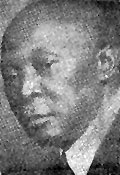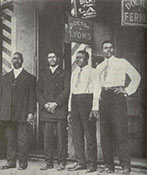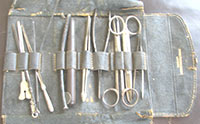Black Doctors in Houston (1900-1926, Section 6)
Home to almost 45,000 people at the turn of the twentieth century, Houston was a commercial and railroad hub for the export of cotton, but it stood at the precipice of dramatic change.
The discovery of oil at Spindletop, a field near Beaumont, Texas, in 1901 and the completion of the Houston Ship Channel in 1914 helped make Houston the center of the nation’s petroleum industry. By 1930, it was Texas’s largest city with a population of 292,000.
Segregation of Houston neighborhoods
In 1900, Houston was physically divided into political sections known as wards, and African Americans were segregated primarily into the Fourth Ward and the Third Ward. In the first few years of the new century, only a handful of African American physicians to care for an estimated 14,000 African Americans who made Houston their home. All but one of them kept his office in the Fourth Ward, which also was known as Freedmen’s Town, the original name given by the freed slaves who settled there after the Civil War. Most of Houston’s more prosperous African Americans lived in this neighborhood.
A member of Meharry’s third graduating class in 1880, Dr. E.B. Ramsey became the first African-American physician to practice in Houston shortly thereafter. A handful of doctors, such as Dr. Franklin Robey, followed him. Dr. Benjamin Jesse Covington was a native of Marlin, Texas, a small town just south of Waco. He worked his way through college at the Hearne Baptist Academy and through medical school at Meharry Medical College, graduating from the latter in 1900. Three years later, he returned to Texas, and then, in 1906, began practicing medicine in Houston.
Dr. Henry E. Lee, who had written about the “Negro Health Problem,” graduated from Tillotson College, a historically black institution in Austin, Texas. He earned his M.D. at Meharry Medical College in 1902, and opened his surgical practice in Houston in 1910. Dr. George Washington Antoine graduated from Meharry Medical College in 1906 at age 28 and moved to Houston. Dr. Thomas Shadowens was born in Tacoma, Texas, a small, rural community that no longer exists along the Texas-Louisiana border. Dr. Shadowens, who graduated from Meharry Medical College in 1917, sold his own patent medicine called Shadolox, until World War II when he abandoned its production due to the unavailability of an ingredient found only in Hawaii.
Physicians and patients continued to use such medicines in the decades following the Flexner Report, reflecting an ongoing “medical pluralism” in the United States.
Most of the black doctors in Houston, like more than 75 percent of the physicians in the United States at the beginning of the twentieth century, were general practitioners. General practitioners treated patients of all ages for any health concerns. They set broken bones, treated infectious diseases, and sometimes operated.
A trend toward greater specialization emerged in the early 1900s, but many practicing physicians initially resisted the trend. Then as now, generalists prided themselves on being “patient focused,” while specialists were “disease focused.” Most African Americans also were general practitioners, in part, because they were denied admission to specialized training programs.
General practitioners usually worked out of their office or made house calls. A doctor traveled by carriage or by car, rain or shine, day or night, spending hours on the road. As of 1904, for example, 95 percent of the nation’s births still occurred at home rather than in hospitals, and midwives often managed these births, only calling on physicians when complications occurred.
Whether the physicians had set a leg or delivered a baby, patients sometimes lacked money and paid the doctors with food, firewood, or other goods. Through their house calls, African-American doctors met large numbers of the Houston community and formed close relationships with their patients. By virtue of those relations and their education, they became community leaders, advocating for better conditions and gaining the respect of those around them.




